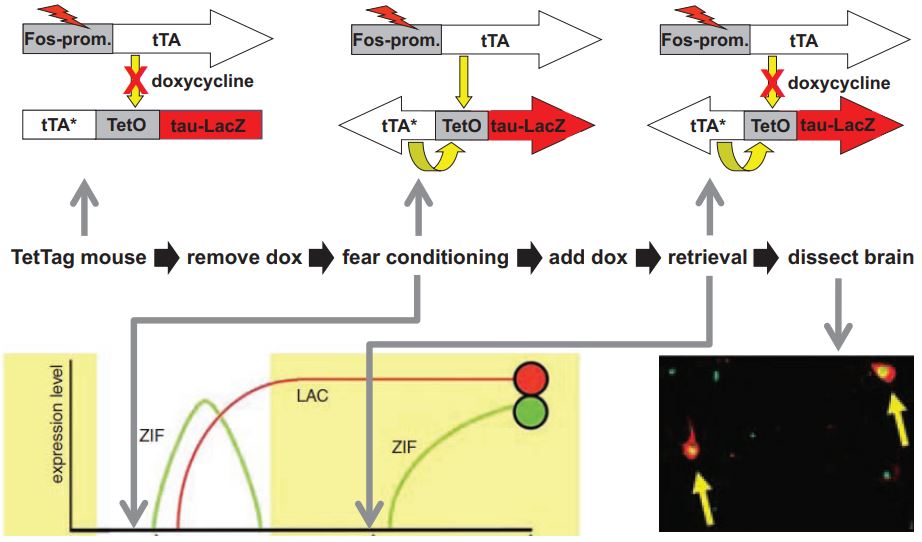TetTag on:
[Wikipedia]
[Google]
[Amazon]
 The TetTag mouse is a bi-
The TetTag mouse is a bi-
 The TetTag mouse is a bi-
The TetTag mouse is a bi-transgenic
A transgene is a gene that has been transferred naturally, or by any of a number of genetic engineering techniques, from one organism to another. The introduction of a transgene, in a process known as transgenesis, has the potential to change the ...
mutant used in neuroscience research that expresses a persistent marker (e.g. beta-galactosidase) under control of the immediate early gene
Immediate early genes (IEGs) are genes which are activated transiently and rapidly in response to a wide variety of cellular stimuli. They represent a standing response mechanism that is activated at the transcription level in the first round of ...
''fos''. This mouse strain allows the stable labeling of activated neurons in mice in a defined time window of several hours.
Description
Two independently generated transgenic strains were crossed to produce the TetTag strain. In the first transgenic construct, the tetracycline-controlled transactivator (tTA) protein and a two hour half-lifeGreen Fluorescent Protein
The green fluorescent protein (GFP) is a protein that exhibits green fluorescence when exposed to light in the blue to ultraviolet range. The label ''GFP'' traditionally refers to the protein first isolated from the jellyfish ''Aequorea victo ...
(shEGFP) are expressed under the direction of the '' fos'' minimal promoter. The second transgenic construct expresses a nuclear-localizing beta-galactosidase gene and the tetracycline regulated transactivator In the context of gene regulation: transactivation is the increased rate of gene expression triggered either by biological processes or by artificial means, through the expression of an intermediate transactivator protein.
In the context of recep ...
(tTA) under the control of the TetO tetracycline-responsive regulatory element.
Memory research
The TetTag mouse allows researchers to label activated neurons during a learning experiment (e.g.fear conditioning
Pavlovian fear conditioning is a behavioral paradigm in which organisms learn to predict aversive events. It is a form of learning in which an aversive stimulus (e.g. an electrical shock) is associated with a particular neutral context (e.g., a r ...
, water maze training). When the memory is retrieved days later, the acutely activated neurons can be labeled by immunohistochemistry
Immunohistochemistry is a form of immunostaining. It involves the process of selectively identifying antigens in cells and tissue, by exploiting the principle of Antibody, antibodies binding specifically to antigens in biological tissues. Alber ...
against immediate early gene
Immediate early genes (IEGs) are genes which are activated transiently and rapidly in response to a wide variety of cellular stimuli. They represent a standing response mechanism that is activated at the transcription level in the first round of ...
s. These experiments test whether the same neurons are responsible for storing and retrieving a memory, a key question to understand the cellular mechanism of memory.
Limitations
The removal ofdoxycycline
Doxycycline is a Broad-spectrum antibiotic, broad-spectrum antibiotic of the Tetracycline antibiotics, tetracycline class used in the treatment of infections caused by bacteria and certain parasites. It is used to treat pneumonia, bacterial p ...
from the chow opens the window for activity-dependent labeling, but it takes several hours for the drug to be cleared from the brain. Thus, the labeling window is not very precise in time. Also, it is not entirely clear which activity patterns lead to Fos activation in neurons.
References
{{Reflist Neuroscience Mouse genetics